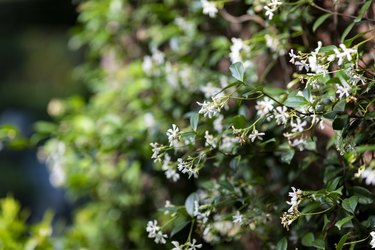
The word "aerial" refers to as anything that exists in the air or in the space above a solid surface. The aerial part of plants simply denotes the structures of a plant that are above ground, including the stems, leaves, petioles, flowers, fruits and seeds. Other than fulfilling an aesthetic quality for those of us who enjoy looking at plants, these aerial parts are also responsible, among other things, for producing much of the food a plant needs to survive.
Aerial Part of Plants Beginnings
Video of the Day
When a plant seed germinates, it simultaneously sends a taproot into the ground and a shoot above the ground. The shoot is the first aerial part and consists of a tiny stem from which a pair of false leaves called cotyledons emerge. These leaves soon give way to the subsequent development of real leaves, which can be few or many depending on the type of plant. The tiny shoot grows and becomes the plant's main stem.
Video of the Day
Side stems, or petioles, emerge from the main stem and support the leaves. Vining plants also may develop tendrils, or small curly fibers designed to anchor the plants to some type of support such as a trellis or arbor. Most plants develop some type of flower whose task it is to produce seeds that ensure their propagation. Some plants, such as apple trees, produce fruit that contain the seeds.
Aerial Part of Plants Functionality
Each aerial plant part has a distinct purpose and each contributes to the plant's health and survival. The main stem transports water and nutrients up from the roots and distributes them via the side stems and branches to the leaves. The leaves act as solar collectors, trapping and storing the sun's energy for use during photosynthesis, the process by which plants manufacture their own food.
The leaves also store water, which is necessary for photosynthesis, and release unused water through a process known as transpiration. The flowers act as bait to lure insects and birds to the plant for pollination, and once fertilized, they produce the seeds that make it possible to grow other plants of that species.
Aerial Part of Plants Synergy
All plants are truly the sum of their individual parts, and they could not exist if any of those parts failed to function. The aerial parts work in conjunction with the subterranean parts toward the common goal of sustaining the plant, keeping it alive and allowing it to function according to its species. The roots supply the plant with water and nutrients from the soil, and the aerial parts access nutrients and water from the air. If disease, insect infestation or drought affects any above-ground part, it affects the whole plant and the plant may die if conditions continue.
Aerial Part of Plants Aesthetics
Not only do the aerial parts of a plant keep it alive and producing more of its kind, they are also the parts that are visible and that add beauty to the world. Foliage plants provide visual lushness to the landscape, while flowering plants add color and interest to gardens, fields and windowsills. Plants also filter and purify the air and contribute large amounts of oxygen to the atmosphere that is necessary to the survival of all mammals, including humans.